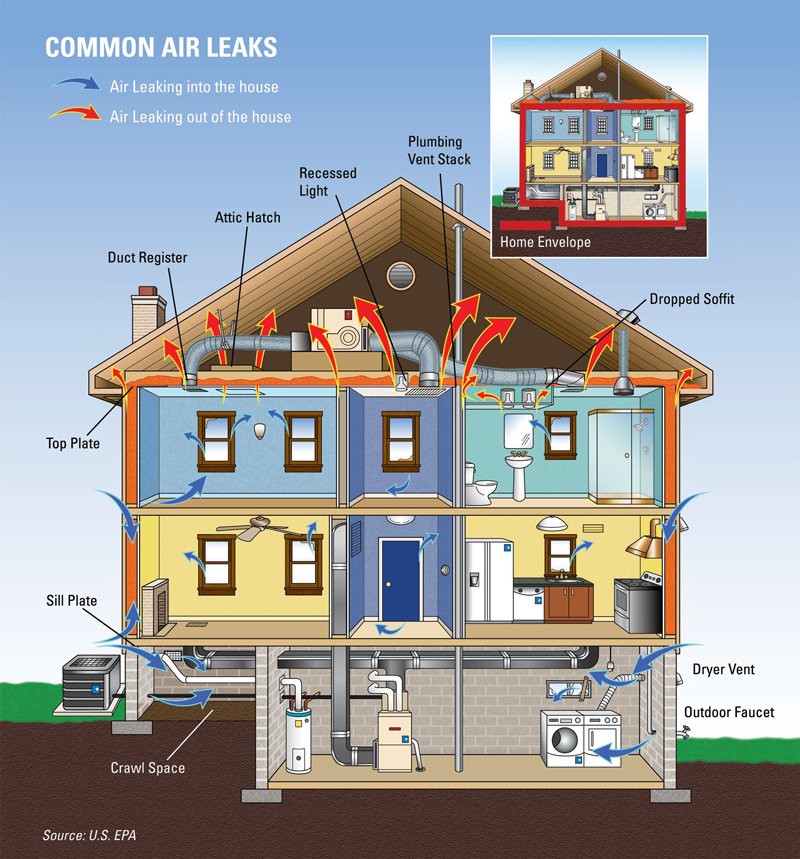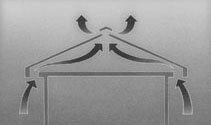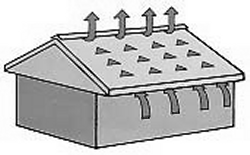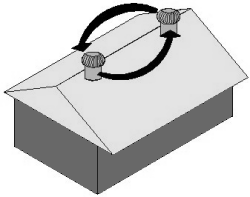Why Insulate Your House?
Heating and cooling account for 50 to 70% of the energy used in the average American home. Inadequate insulation and air leakage are leading causes of energy waste in most homes. Insulation:
![]() Saves
money and our nation's limited energy resources
Saves
money and our nation's limited energy resources
![]() Makes
your house more comfortable by helping to maintain a uniform temperature
throughout the house
Makes
your house more comfortable by helping to maintain a uniform temperature
throughout the house
![]() Makes
walls, ceilings, and floors warmer in the winter and cooler in the
summer.
Makes
walls, ceilings, and floors warmer in the winter and cooler in the
summer.
The amount of energy you conserve will depend on several factors: your local climate; the size, shape, and construction of your house; the living habits of your family; the type and efficiency of the heating and cooling systems; and the fuel you use. Once the energy savings have paid for the installation cost, energy conserved is money saved - and saving energy will be even more important as utility rates go up.
This fact sheet will help you to understand how insulation works, what different types of insulation are available, and how much insulation makes sense for your climate. There are many other things you can do to conserve energy in your home as well.
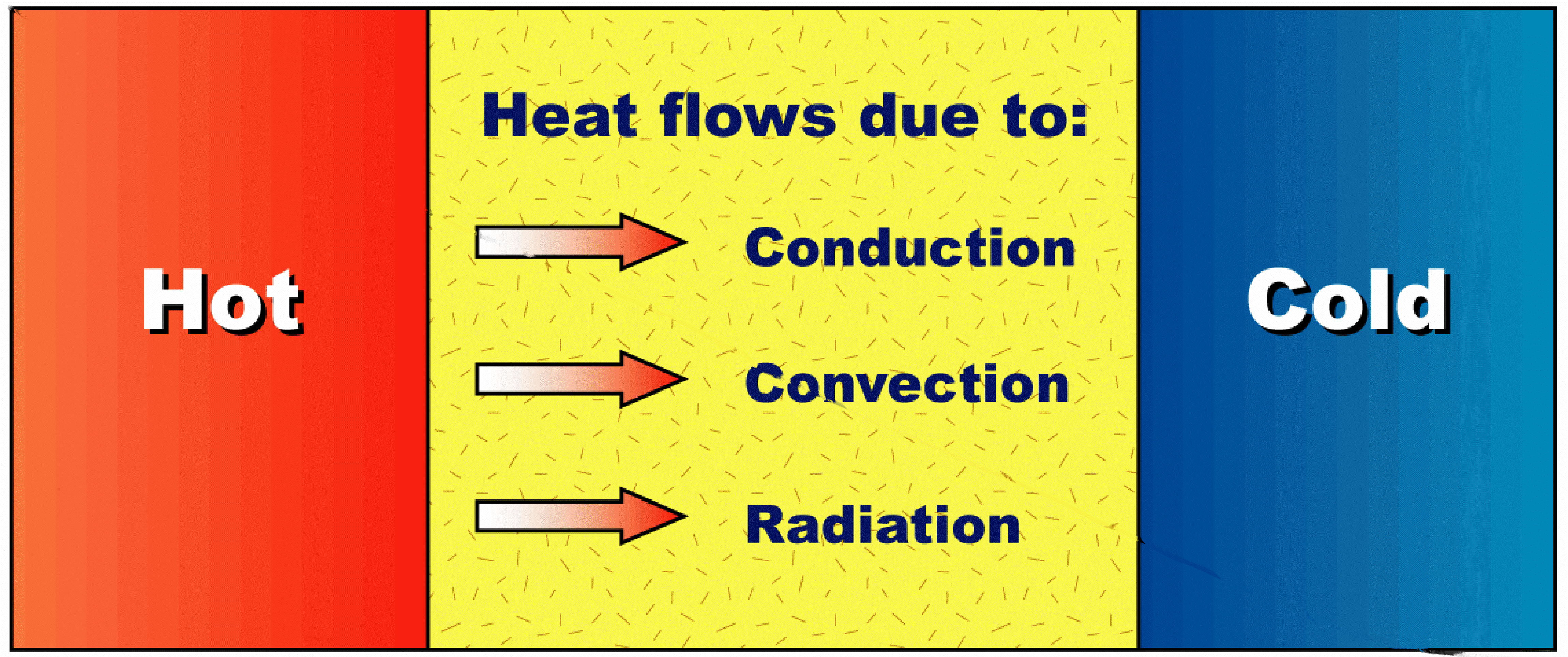 |
Heat flows naturally from a warmer to a cooler space. In winter, the heat moves directly from all heated living spaces to the outdoors and to adjacent unheated attics, garages, and basements - wherever there is a difference in temperature. During the summer, heat moves from outdoors to the house interior. To maintain comfort, the heat lost in winter must be replaced by your heating system and the heat gained in summer must be removed by your air conditioner. Insulating ceilings, walls, and floors decreases the heating or cooling needed by providing an effective resistance to the flow of heat. |
 |
The ability of insulation to limit air movement should not be confused with "air sealing". The insulation reduces air movement only within the space it occupies. It will not reduce air movement through other cracks between building parts. For example, controllong air within a wall cavity will not stop air that leakes between the foundation and the sill plate or between the wall joists and a window frame |
Blower
Door Guided Air Sealing
Many
air leaks and drafts are easy to find because they are easy to feel
- like those around windows and doors. But holes hidden in attics,
basements, and crawlspaces are usually bigger problems. Sealing
these leaks with caulk, spray foam, or weather stripping will have
a great impact on improving your comfort and
reducing utility bills.
Homeowners are often concerned about sealing their house too tightly;
however, this is unlikely in most older homes. A certain amount
of fresh air is needed for good indoor air quality and there are
specifications that set the minimum amount of fresh air needed for
a house.
Kilroy Technicians are skilled in evaluating current and needed
air flow, systematically reducing excessive infiltration and carefully
adhering to important indoor air quality standards.
Ventilation
Attic ventilation
is an important part of roofing. Proper attic ventilation extends
the life of a roof and reduces problems because it minimizes the
temperature differential between the attic and the air outside.
Proper ventilation will remove moisture and heat from the attic.
Trapped heat and moisture can raise energy costs, cause ice dams,
and damage roof system components as well as structural and personal
items located inside the attic where temperatures can easily reach
150° F (65° C). Condensation that forms inside attics can
be caused by the use of washing machines, dish washers, bath tubs,
showers, and tumble driers unless these items are properly ventilated
through the roof. In some cases the condensation can be bad enough
to be mistaken for a roof leak.
Here
are some problems associated with an improperly ventilated attic
space. Sumps between rafters (deck deflection) can happen because
after awhile (sometimes several years, sometimes only a couple years),
a plywood roof deck can warp or deteriorate and become spongy and
dangerous to walk on. This occurs because one side of plywood decking
needs be able to "breathe" by being exposed to circulating
air. The adhesives used in the plywood can deteriorate or Dry Rot
can occur because of condensation.
Water vapor will condense first on anything metal inside the attic;
this will eventually cause the metal to rust. Heads can rust off
nails, metal plumbing straps or straps holding HVAC ducting can
rust in two causing the ducting to crash down on top of the ceiling
joists or through a suspended ceiling. This problem is more common
in humid climates.
In colder climates - generally where the average January temperature
is 32° F (0° C) or colder - high inside humidity (40% or
greater) combined with low outside temperatures can cause frost
to form on the bottom of the roof deck.
Insulation can trap moisture which will reduce the R-value of the insulation and create a nice environment for the propagation of certain molds, spores, and fungi which will also cause problems.There is also the problem of mildew which is both damaging and can cause health problems.
The
roof system itself will deteriorate prematurely.
Cooling units will need to be serviced or replaced prematurely because
of excessive use.
Ice Dams - ice dams are the result of melting snow continually refreezing
at the roof perimeter and then backing up under the shingles and
causing leaks. Proper ventilation used in conjunction with heavy
insulation and an air barrier can create a Cold Roof Assembly which
will help eliminate ice dams.
Since 1977
Kilroy Home Insulation offers a variety of services.
Click below
for more information regarding new replacement windows and doors
![]() www.dovewindows.com
www.dovewindows.com
![]() www.sprousewindows.com
www.sprousewindows.com
Helpful and Informative Links

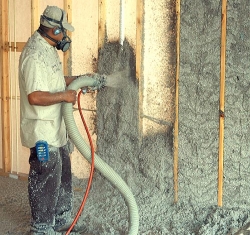
Does
your home need more insulation?
Unless your home was constructed with special attention to energy
efficiency, adding insulation will probably reduce your utility
bills. Much of the existing housing stock in the United States
was not insulated to the levels used today. Older homes are likely
to use more energy than newer homes, leading to higher heating
and air-conditioning bills.
Where
and How Much Insulation
Adding
more insulation where you already have some, such as in an attic,
will save energy. You can save even greater amounts of energy
if you install insulation into places in your home that have never
been insulated. Figure
1 shows which building spaces should be insulated. These might
include an uninsulated floor over a garage or crawlspace, or a
wall that separates a room from the attic. Figure
3 can give you general guidance regarding the appropriate
amount of insulation you should add to your home.

Kilroy
Home Insulation Inc. •874 E. 140th Street •Cleveland, Ohio
44110 •Office: (216) 681-2500 Fax:
(216) 681-4811
•Email: bkilroyinc@aol.com Contact Bill Kilroy •Cell: (216)
215-1029 •Privacy Statement
